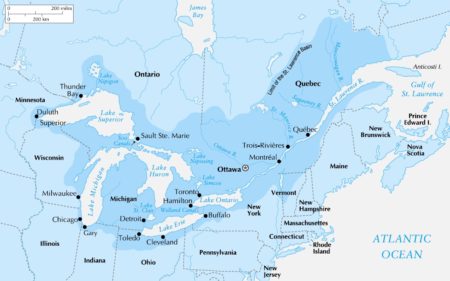MiCorps was created in 2003 to assist the Michigan Department of Environmental Quality in collecting and sharing water quality data for use in water resources management and protection programs. It is comprised of two programs: the Volunteer Stream Monitoring Program (VSMP) and the Cooperative Lakes Monitoring Program (CLMP). With support from MiCorps staff, volunteers participating in the CLMP receive training to collect data and monitor a series of parameters that are essential in assessing the condition of their lake.
The CLMP has been very successful and provided crucial information about the lakes in Michigan, but what about the other states and provinces in the Great Lakes-St. Lawrence River basin? Where can you find similar programs? What are they looking at? How can you reach them? Below you can explore the volunteer-based programs focusing on lake monitoring around the basin. 
Michigan: Cooperative Lakes Monitoring Program, coordinated by the Michigan Department of Environmental Quality, the Great Lakes Commission, the Huron River Watershed Council, Michigan State University and the Michigan Lake and Stream Associations
Parameters monitored: Water transparency, phosphorus, chlorophyll, dissolved oxygen, temperature, aquatic plants, exotic aquatic plants, shoreline habitat assessment
Minnesota: Citizen Lake Monitoring Program, coordinated by the Minnesota Pollution Control Agency
Parameters monitored: Water transparency, dissolved oxygen, temperature, alkalinity, chloride, chlorophyll, color, nitrogen, phosphorus
*Volunteers are also encouraged to participate in the Lake Ice Reporter Program.
Wisconsin: Citizen Lake Monitoring Network, coordinated by the University of Wisconsin Extension and Wisconsin Department of Natural Resources
Parameters monitored: Water transparency, phosphorus, chlorophyll, aquatic invasive species, native plants, ice cover duration
Illinois: Volunteer Lake Monitoring Program, coordinated by the Illinois Environmental Protection Agency
Parameters monitored: Water transparency, nutrients, suspended solids, chlorophyll, dissolved oxygen, temperature
Indiana: Clean Lakes Program (Volunteer Lake Monitoring Program), coordinated by the Indiana University School of Public and Environmental Affairs
Parameters monitored: Water transparency, dissolved oxygen, temperature, aquatic invasive species, chlorophyll, phosphorus
Ohio: Citizen Lake Awareness and Monitoring Program, coordinated by the Ohio Lake Management Society
Parameters monitored: Water transparency, temperature, dissolved oxygen, color, chlorophyll, phosphorus, nitrogen, total suspended sediments
Pennsylvania: No statewide program
New York: Citizen Statewide Lake Assessment Program, coordinated by the New York State Department of Environmental Conservation and the New York State Federation of Lake Associations
Parameters monitored: Water transparency, temperature, conductivity, pH, color, phosphorus, nitrogen, chlorophyll, calcium, use impairment surveys
Vermont: Lay Monitoring Program, coordinated by the Vermont Department of Environmental Conservation
Parameters monitored: Water transparency, phosphorus, chlorophyll
Ontario: Lake Partner Program, coordinated by the Ontario Ministry of Environment and Climate Change and the Federation of Ontario Cottagers’ Associations
Parameters monitored: Water transparency, phosphorus, calcium, chloride, dissolved organic carbon, sulfate
Quebec: Volunteer Lake Monitoring Program, coordinated by the Quebec Ministry of Sustainable Development, Environment and Fight Against Climate Change
Parameters monitored: Water transparency, phosphorus, dissolved organic carbon, chlorophyll, invasive exotic aquatic plants, periphyton, shoreline habitat, substrate
Download the summary table for more details on these programs.





